Mcat organic - Study guides, Class notes & Summaries
Looking for the best study guides, study notes and summaries about Mcat organic? On this page you'll find 195 study documents about Mcat organic.
Page 2 out of 195 results
Sort by
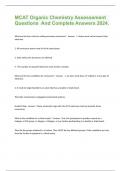
-
MCAT Organic Chemistry Assessement Questions And Complete Answers 2024.
- Exam (elaborations) • 34 pages • 2024
- Available in package deal
-
- $9.79
- + learn more
What are the four rules for writing resonance structures? - Answer 1. Atoms must not be moved. Only electrons. 2. All resonance atoms must lie in the same plane. 3. Only valid Lewis structures are allowed. 4 . The number of unpaired electrons must remain constant. What are the two conditions for resonance? - Answer 1. An atom must have a P orbital or a lone pair of electrons. 2. It must be single bonded to an atom that has a double or triple bond. The latter compromise conj...
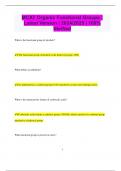
-
MCAT Organic Functional Groups | Latest Version | 2024/2025 | 100% Verified
- Exam (elaborations) • 10 pages • 2024
- Available in package deal
-
- $9.78
- + learn more
MCAT Organic Functional Groups | Latest Version | 2024/2025 | 100% Verified What is the functional group of alcohols? The functional group of alcohols is the hydroxyl group (-OH). What defines an aldehyde? An aldehyde has a carbonyl group (C=O) attached to at least one hydrogen atom. What is the characteristic feature of carboxylic acids? Carboxylic acids feature a carboxyl group (-COOH), which consists of a carbonyl group attached to a hydroxyl group. What functional g...
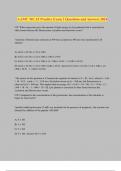 Popular
Popular
-
AAMC MCAT Practice Exam 2 Questions and Answers 2024
- Exam (elaborations) • 68 pages • 2024
- Available in package deal
-
- $13.49
- 1x sold
- + learn more
AAMC MCAT Practice Exam 2 Questions and Answers 2024 C/P: What expression gives the amount of light energy (in J per photon) that is converted to other forms between the fluorescence excitation and emission events? "intensity of fluorescence emission at 440 nm excitation at 360 nm) was monitored for 20 minutes" A) (6.62 × 10-34) × (3.0 × 108) B) (6.62 × 10-34) × (3.0 × 108) × (360 × 10-9) C) (6.62 × 10-34) × (3.0 × 108) × [1 / (360 × 10-9) - 1 / (440 × 10-9)] D) (6.62 × ...

-
MCAT Organic Functional Groups fully solved
- Exam (elaborations) • 2 pages • 2024
- Available in package deal
-
- $9.99
- + learn more
MCAT Organic Functional Groups alkane - correct answer alkene - correct answer alkyne - correct answer alkyl halide - correct answer alcohol - correct answer thiol - correct answer ether - correct answer oxirane (epoxide) - correct answer phenol - correct answer aldehyde - correct answer ketone - correct answer hemiacetal - correct answer acetal - correct answer ( not H, but another R) so R1, R2, OR1, OR2
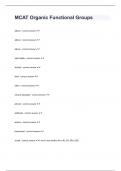
-
MCAT Organic Functional Groups with verified answered latest update
- Exam (elaborations) • 2 pages • 2024
- Available in package deal
-
- $9.99
- + learn more
MCAT Organic Functional Groupsalkane - correct answer alkene - correct answer alkyne - correct answer alkyl halide - correct answer alcohol - correct answer thiol - correct answer ether - correct answer oxirane (epoxide) - correct answer phenol - correct answer aldehyde - correct answer ketone - correct answer hemiacetal - correct answer acetal - correct answer ( not H, but another R) so R1, R2, OR1, OR2
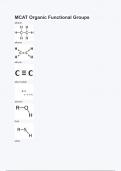
-
MCAT Organic Functional Groups (ANSWERS) 2024 - DISTINCTION GUARANTEED / Complete Verified Latest Version
- Exam (elaborations) • 4 pages • 2024
- Available in package deal
-
- $11.49
- + learn more
MCAT Organic Functional Groups (ANSWERS) 2024 - DISTINCTION GUARANTEED / Complete Verified Latest Version
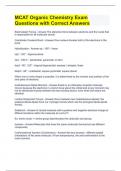
-
MCAT Organic Chemistry Exam Questions with Correct Answers
- Exam (elaborations) • 20 pages • 2024
- Available in package deal
-
- $16.49
- + learn more
Electrostatic Forces - Answer-The attractive force between electrons and the nuclei that is responsible for all molecular bonds. Coordinate Covalent Bond - Answer-One nucleus donates both of the electrons in the bond. Hybridization - Answer-sp - 180° - linear sp2 - 120° - trigonal planar sp3 - 109.5° - tetrahedral, pyramidal, or bent dsp3 - 90°, 120° - trigonal-bipyramidal, seesaw, t-shaped, linear d2sp3 - 90° - octahedral, square pyramidal, square planar When one or m...
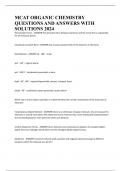
-
MCAT ORGANIC CHEMISTRY QUESTIONS AND ANSWERS WITH SOLUTIONS 2024
- Exam (elaborations) • 27 pages • 2024
- Available in package deal
-
- $14.99
- + learn more
MCAT ORGANIC CHEMISTRY QUESTIONS AND ANSWERS WITH SOLUTIONS 2024
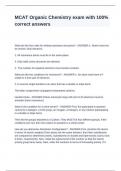
-
MCAT Organic Chemistry exam with 100- correct answers
- Exam (elaborations) • 31 pages • 2024
-
- $10.49
- + learn more
What are the four rules for writing resonance structures? 1. Atoms must not be moved. Only electrons. 2. All resonance atoms must lie in the same plane. 3. Only valid Lewis structures are allowed. 4 . The number of unpaired electrons must remain constant. What are the two conditions for resonance? 1. An atom must have a P orbital or a lone pair of electrons. 2. It must be single bonded to an atom that has a double or triple bond. The latter compromise conjugated unsaturat...
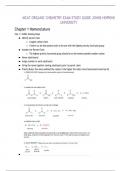
-
MCAT ORGANIC CHEMISTRY EXAM STUDY GUIDE JOHNS HOPKINS UNIVERSITY
- Exam (elaborations) • 29 pages • 2024
-
- $26.99
- + learn more
MCAT ORGANIC CHEMISTRY EXAM STUDY GUIDE JOHNS HOPKINS UNIVERSITY Chapter 1 Nomenclature Chp 1.1 IUPAC Naming Steps ● Identify parent chain ○ Longest carbon chain ○ If there is a tie then parent chain is the one with the highest priority functional group ● Number the Parnet Chain ○ The highest priority functional group should be on the lowest possible number carbon ● Name substituents ● Assign nu

$6.50 for your textbook summary multiplied by 100 fellow students... Do the math: that's a lot of money! Don't be a thief of your own wallet and start uploading yours now. Discover all about earning on Stuvia


